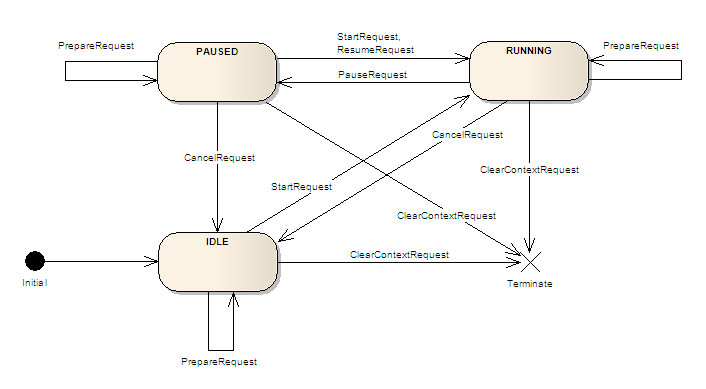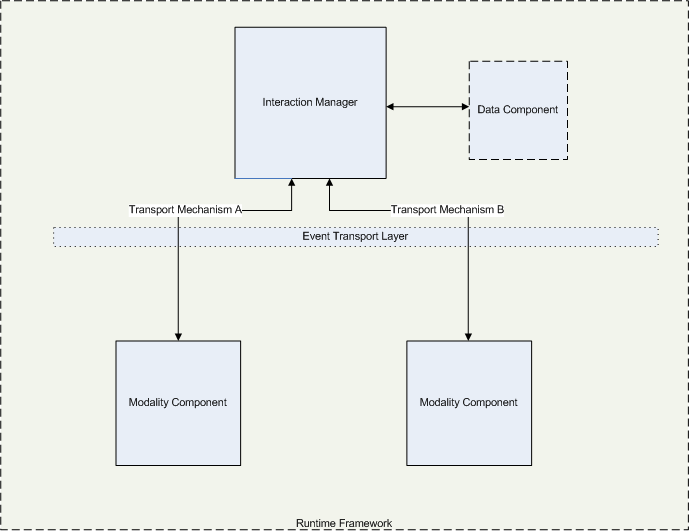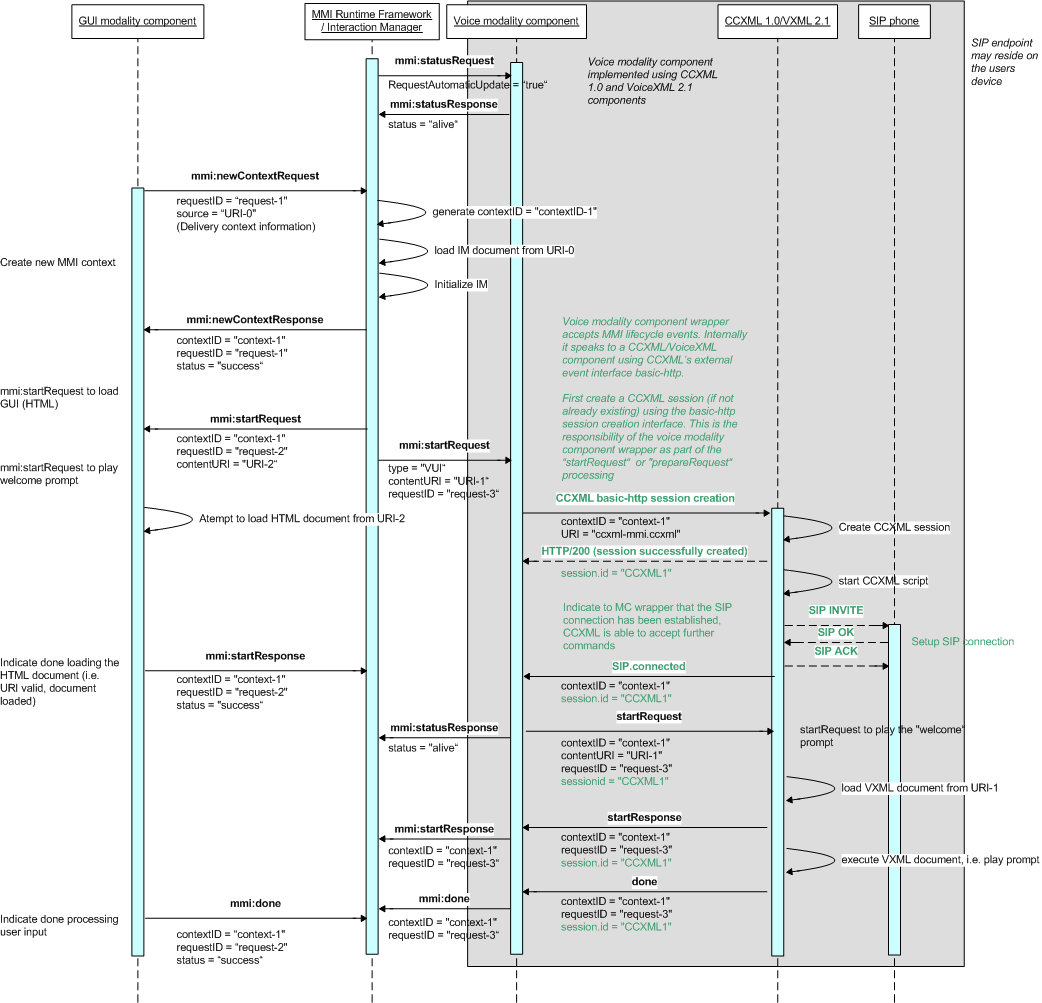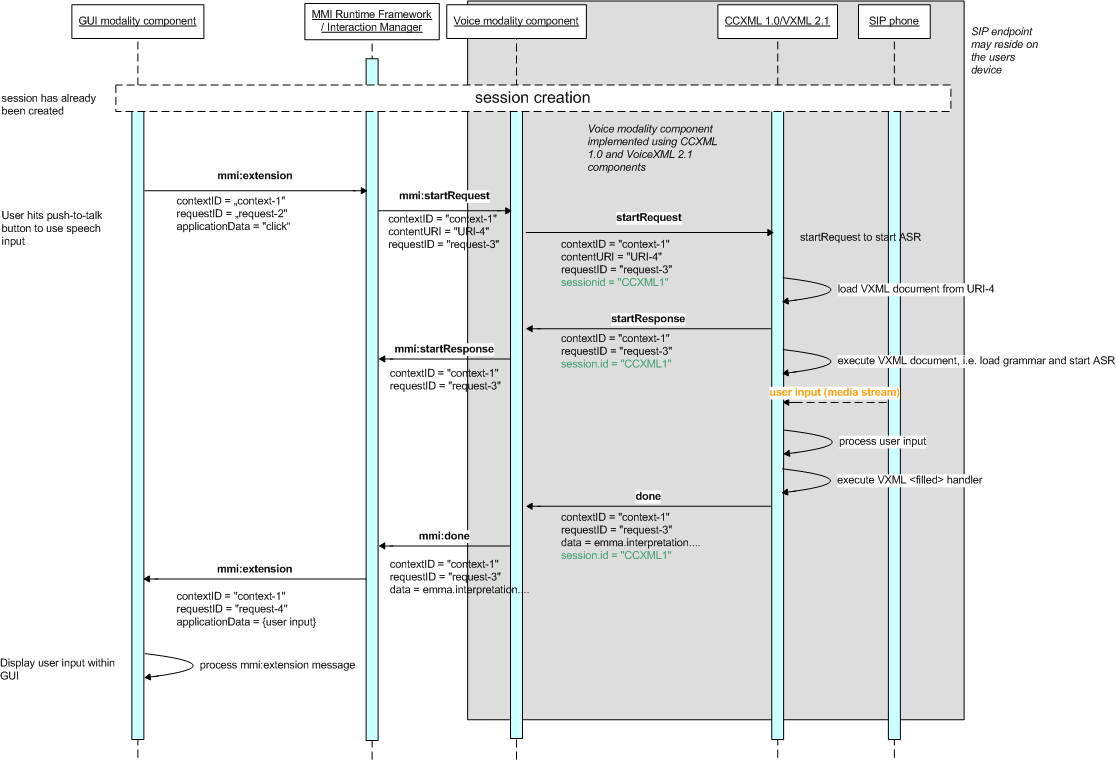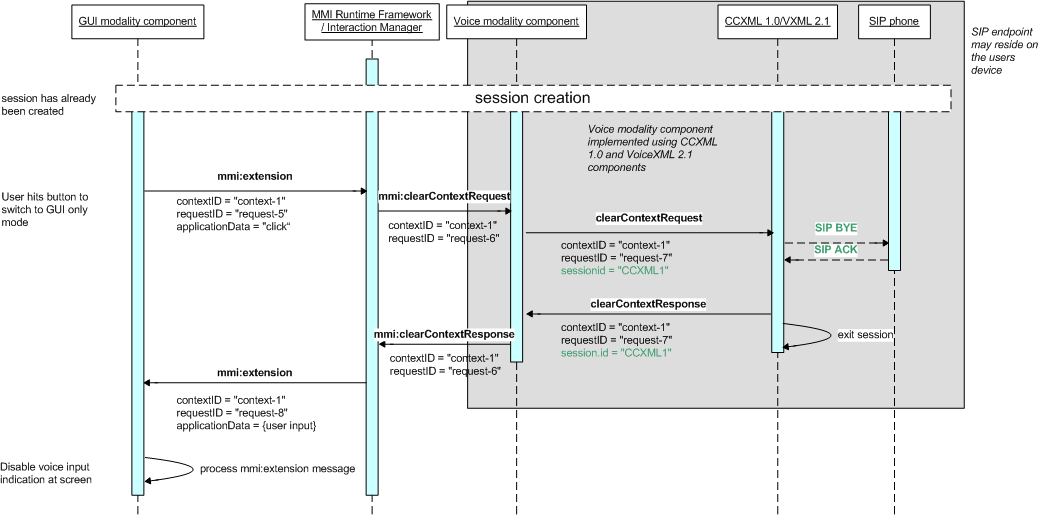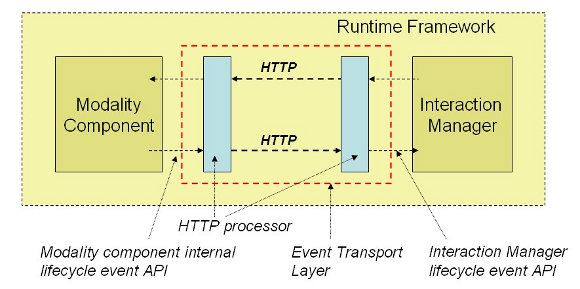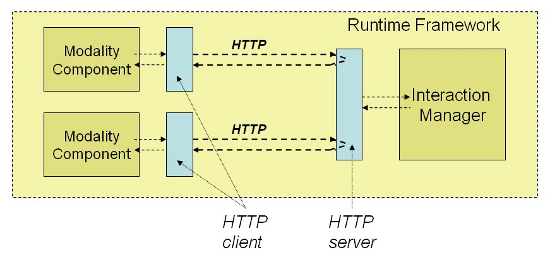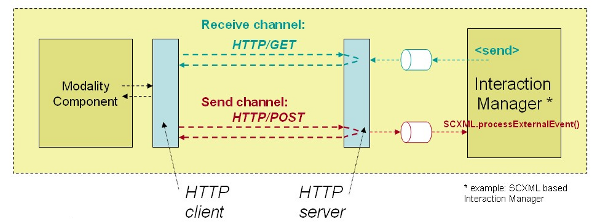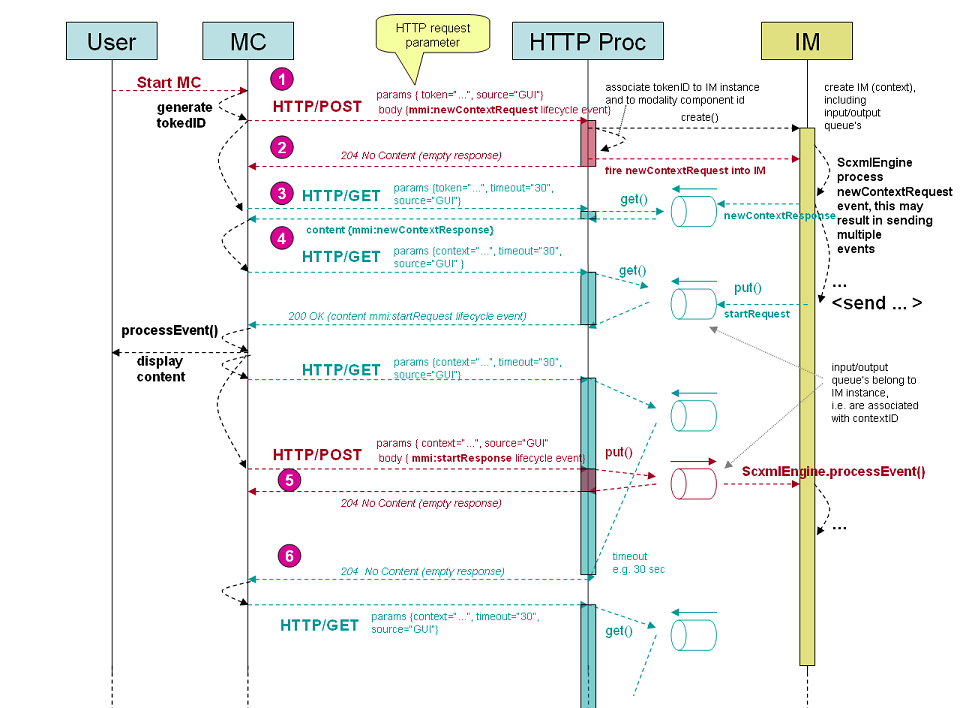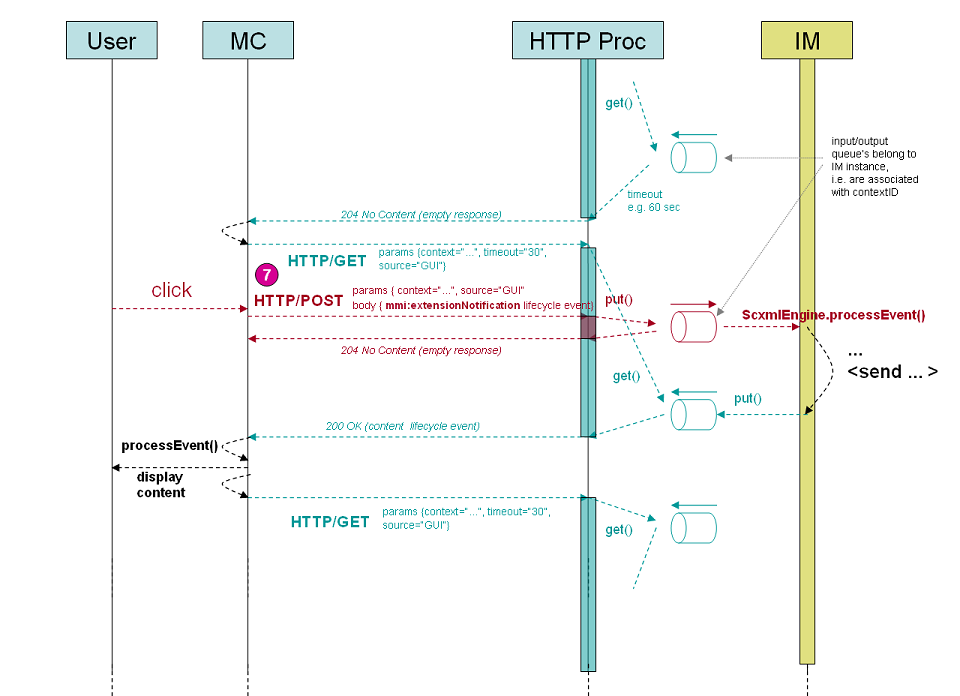2 Overview
This document describes the architecture of the Multimodal
Interaction (MMI) framework [MMIF] and the
interfaces between its constituents. The MMI Working Group is aware
that multimodal interfaces are an area of active research and that
commercial implementations are only beginning to emerge. Therefore
we do not view our goal as standardizing a hypothetical existing
common practice, but rather providing a platform to facilitate
innovation and technical development. Thus the aim of this design
is to provide a general and flexible framework providing
interoperability among modality-specific components from different
vendors - for example, speech recognition from one vendor and
handwriting recognition from another. This framework places very
few restrictions on the individual components or on their
interactions with each other, but instead focuses on providing a
general means for allowing them to communicate with each other,
plus basic infrastructure for application control and platform
services.
Our framework is motivated by several basic design goals:
- Encapsulation. The architecture should make no assumptions
about the internal implementation of components, which will be
treated as black boxes.
- Distribution. The architecture should support both distributed
and co-hosted implementations.
- Extensibility. The architecture should facilitate the
integration of new modality components. For example, given an
existing implementation with voice and graphics components, it
should be possible to add a new component (for example, a biometric
security component) without modifying the existing components.
- Recursiveness. The architecture should allow for nesting, so
that an instance of the framework consisting of several components
can be packaged up to appear as a single component to a
higher-level instance of the architecture.
- Modularity. The architecture should provide for the separation
of data, control, and presentation.
Even though multimodal interfaces are not yet common, the
software industry as a whole has considerable experience with
architectures that can accomplish these goals. Since the 1980s, for
example, distributed message-based systems have been common. They
have been used for a wide range of tasks, including in particular
high-end telephony systems. In this paradigm, the overall system is
divided up into individual components which communicate by sending
messages over the network. Since the messages are the only means of
communication, the internals of components are hidden and the
system may be deployed in a variety of topologies, either
distributed or co-located. One specific instance of this type of
system is the DARPA Hub Architecture, also known as the Galaxy
Communicator Software Infrastructure [Galaxy]. This is a distributed,
message-based, hub-and-spoke infrastructure designed for
constructing spoken dialogue systems. It was developed in the late
1990's and early 2000's under funding from DARPA. This
infrastructure includes a program called the Hub, together with
servers which provide functions such as speech recognition, natural
language processing, and dialogue management. The servers
communicate with the Hub and with each other using key-value
structures called frames.
Another recent architecture that is relevant to our concerns is
the model-view-controller (MVC) paradigm. This is a well known
design pattern for user interfaces in object oriented programming
languages, and has been widely used with languages such as Java,
Smalltalk, C, and C++. The design pattern proposes three main
parts: a Data Model that represents the underlying logical
structure of the data and associated integrity constraints, one or
more Views which correspond to the objects that the user
directly interacts with, and a Controller which sits
between the data model and the views. The separation between data
and user interface provides considerable flexibility in how the
data is presented and how the user interacts with that data. While
the MVC paradigm has been traditionally applied to graphical user
interfaces, it lends itself to the broader context of multimodal
interaction where the user is able to use a combination of visual,
aural and tactile modalities.
3 Design versus Run-Time
considerations
In discussing the design of MMI systems, it is important to keep
in mind the distinction between the design-time view (i.e., the
markup) and the run-time view (the software that executes the
markup). At the design level, we assume that multimodal
applications will take the form of multiple documents from
different namespaces. In many cases, the different namespaces and
markup languages will correspond to different modalities, but we do
not require this. A single language may cover multiple modalities
and there may be multiple languages for a single modality.
At runtime, the MMI architecture features loosely coupled
software constituents that may be either co-resident on a device or
distributed across a network. In keeping with the loosely-coupled
nature of the architecture, the constituents do not share context
and communicate only by exchanging events. The nature of these
constituents and the APIs between them is discussed in more detail
in Sections 3-5, below. Though nothing in the MMI architecture
requires that there be any particular correspondence between the
design-time and run-time views, in many cases there will be a
specific software component responsible for each different markup
language (namespace).
3.1 Markup and The Design-Time
View
At the markup level, an application consists of multiple
documents. A single document may contain markup from different
namespaces if the interaction of those namespaces has been defined
(e.g., as part of the Compound Document Formats Activity [CDF].) By the principle of encapsulation, however,
the internal structure of documents is invisible at the MMI level,
which defines only how the different documents communicate. One
document has a special status, namely the Root or Controller
Document, which contains markup defining the interaction between
the other documents. Such markup is called Interaction Manager
markup. The other documents are called Presentation Documents,
since they contain markup to interact directly with the user. The
Controller Document may consist solely of Interaction Manager
markup (for example a state machine defined in CCXML [CCXML] or SCXML [SCXML]) or
it may contain Interaction Manager markup combined with
presentation or other markup. As an example of the latter design,
consider a multimodal application in which a CCXML document
provides call control functionality as well as the flow control for
the various Presentation documents. Similarly, an SCXML flow
control document could contain embedded presentation markup in
addition to its native Interaction Management markup.
These relationships are recursive, so that any Presentation
Document may serve as the Controller Document for another set of
documents. This nested structure is similar to 'Russian Doll' model
of Modality Components, described below in 3.2 Software Constituents and The Run-Time
View.
The different documents are loosely coupled and co-exist without
interacting directly. Note in particular that there are no shared
variables that could be used to pass information between them.
Instead, all runtime communication is handled by events, as
described below in 5.1 Common
Event Fields.
Furthermore, it is important to note that the asynchronicity of
the underlying communication mechanism does not impose the
requirement that the markup languages present a purely asynchronous
programming model to the developer. Given the principle of
encapsulation, markup languages are not required to reflect
directly the architecture and APIs defined here. As an example,
consider an implementation containing a Modality Component
providing Text-to-Speech (TTS) functionality. This Component must
communicate with the Interaction Manager via asynchronous events
(see 3.2 Software Constituents and The
Run-Time View). In a typical implementation, there would
likely be events to start a TTS play and to report the end of the
play, etc. However, the markup and scripts that were used to author
this system might well offer only a synchronous "play TTS" call, it
being the job of the underlying implementation to convert that
synchronous call into the appropriate sequence of asynchronous
events. In fact, there is no requirement that the TTS resource be
individually accessible at all. It would be quite possible for the
markup to present only a single "play TTS and do speech
recognition" call, which the underlying implementation would
realize as a series of asynchronous events involving multiple
Components.
Existing languages such as XHTML may be used as either the
Controller Documents or as Presentation Documents. Further examples
of potential markup components are given in 4.2.7 Examples
3.2 Software Constituents and
The Run-Time View
At the core of the MMI runtime architecture is the distinction
between the Interaction Manager (IM) and the Modality Components,
which is similar to the distinction between the Controller Document
and the Presentation Documents. The Interaction Manager interprets
the Controller Document while the individual Modality Components
are responsible for specific tasks, particularly handling input and
output in the various modalities, such as speech, pen, video,
etc.
The Interaction Manager receives all the events that the various
Modality Components generate. Those events may be commands or
replies to commands, and it is up to the Interaction Manager to
decide what to do with them, i.e., what events to generate in
response to them. In general, the MMI architecture follows a
'targetless' event model. That is, the Component that raises an
event does not specify its destination. Rather, it passes it up to
the Runtime Framework, which will pass it to the Interaction
Manager. The IM, in turn, decides whether to forward the event to
other Components, or to generate a different event, etc.
Modality Components are black boxes, required only to implement
the Modality Component Interface API which is described below. This
API allows the Modality Components to communicate with the IM and
hence with each other, since the IM is responsible for delivering
events/messages among the Components. Since the internals of a
Component are hidden, it is possible for an Interaction Manager and
a set of Components to present themselves as a Component to a
higher-level Interaction Manager. All that is required is that the
IM implement the Component API. The result is a "Russian Doll"
model in which Components may be nested inside other Components to
an arbitrary depth. Nesting components in this manner is one way to
produce a 'complex' Modality Component, namely one that handles
multiple modalities simultaneously. However, it is also possible to
produce complex Modality Components without nesting, as discussed
in 4.2.3 The Modality
Components.
In addition to the Interaction Manager and the modality
components, there is a Runtime Framework that provides
infrastructure support, in particular a transport layer which
delivers events among the components.
Because we are using the term 'Component' to refer to a specific
set of entities in our architecture, we will use the term
'Constituent' as a cover term for all the elements in our
architecture which might normally be called 'software
components'.
3.3 Differences from Compound
Document Formats
The W3C Compound Document Formats Activity [CDF] is also concerned with the execution of user
interfaces written in multiple languages. However, the CDF group
focuses on defining the interactions of specific sets of languages
within a single document, which may be defined by
inclusion or by reference. The MMI architecture, on the other hand,
defines the interaction of arbitrary sets of languages in
multiple documents. From the MMI point of view, mixed
markup documents defined by CDF specifications are treated like any
other documents, and may be either Controller or Presentation
Documents. Finally, note that the tightly coupled languages handled
by CDF will usually share data and scripting contexts, while the
MMI architecture focuses on a looser coupling, without shared
context. The lack of shared context makes it easier to distribute
applications across a network and also places minimal constraints
on the languages in the various documents. As a result, authors
will have the option of building multimodal applications in a wide
variety of languages for a wide variety of deployment scenarios. We
believe that this flexibility is important for the further
development of the industry.
3.4
Relationship to EMMA
The Extended Multimodal Annotation Language [EMMA], is a set of specifications for multimodal
systems, and provides details of an XML markup language for
containing and annotating the interpretation of user input. For
example, a user of a multimodal application might use both speech
to express a command, and keystroke gesture to select or draw
command parameters. The Speech Recognition Modality would express
the user command using EMMA to indicate the input source (speech).
The Pen Gesture Modality would express the command parameters using
EMMA to indicate the input source (pen gestures). Both modalities
may include timing information in the EMMA notation. Using the
timing information, a fusion module combines the speech and pen
gesture information into a single EMMA notation representing both
the command and its parameters. The use of EMMA enables the
separation of recognition process from the information fusion
process, and thus enables reusable recognition modalities and
general purpose information fusion algorithms.
5 Interface between the
Interaction Manager and the Modality Components
The most important interface in this architecture is the one
between the Modality Components and the Interaction Manager.
Modality Components communicate with the IM via asynchronous
events. Components must be able to raise events and to handle
events that are delivered to them asynchronously. It is not
required that components use these events internally since the
implementation of a given Component is black box to the rest of the
system. In general, it is expected that Components will raise
events both automatically (i.e., as part of their implementation)
and under mark-up control.
The majority of the events defined here come in request/response
pairs. That is, one party (either the IM or an MC) sends a request
and the other returns a response. (The exception is the
ExtensionNotification event, which can be sent by either party.) In
each case it is specified which party sends the request and which
party returns the response. If the wrong party sends a request or
response, the receiving party MUST ignore it. In the descriptions below, we
say that the originating party "MAY" send the request, because it is up to
the internal logic of the originating party to decide if it wants
to invoke the behavior that the request would trigger. On the other
hand, we say that the receiving party "MUST" send the response, because it is
mandatory to send the response if and when the request is
received.
5.1
Common Event Fields
The concept of 'context' is basic to these events described
below. A context represents a single extended interaction with one
(or possibly more) users. In a simple unimodal case, a context can
be as simple as a phone call or SSL session. Multimodal cases are
more complex, however, since the various modalities may not be all
used at the same time. For example, in a voice-plus-web
interaction, e.g., web sharing with an associated VoIP call, it
would be possible to terminate the web sharing and continue the
voice call, or to drop the voice call and continue via web chat. In
these cases, a single context persists across various modality
configurations. In general, we intend for 'context' to cover the
longest period of interaction over which it would make sense for
components to store state or information.
For examples of the concrete XML syntax for all these events,
see A Examples of Life-Cycle
Events
The following common fields are shared by multiple life-cycle
events:
5.1.1 Context
A URI that is unique across the system and is used to identify
this interaction. All events relating to a given interaction will
use the same context URI. Events containing a different context URI
will be part of other, unrelated, interactions.
5.1.2 Source
A URI representing the address of the sender of the event.
5.1.3 Target
A URI representing the address of the destination of the
event.
5.1.4
RequestID
A unique identifier for a Request/Response pair. Most life-cycle
events come in Request/Response pairs that share a common
RequestID. For each such pair, this id must be unique within the
given context.
5.1.5 Status
An enumeration of 'success' and 'failure'. The Response event of
a Request/Response pair will use this field to report whether it
succeeded in carrying out the request.
5.1.6
StatusInfo
An arbitrary value providing further error information in cases
where the status is 'failure'.
5.1.7 Data
An optional field containing arbitrary data. The format and
meaning of this data is application-specific.
5.1.8
Confidential
An optional field indicating whether the contents of this event
should be treated as confidential. The default value is 'false'. If
the value is 'true', the Interaction Manager and Modality Component
implementations MUST not log the information or make it
available in any way to third parties unless explicitly instructed
to do so by the author of the application.
5.2 Standard Life Cycle
Events
The Multimodal Architecture defines the following basic
life-cycle events which must be supported by all modality
components. These events allow the Interaction Manager to invoke
modality components and receive results from them. They thus form
the basic interface between the IM and the Modality components.
Note that the 'Extension' event offers extensibility since it
contains arbitrary XML content and be raised by either the IM or
the Modality Components at any time once the context has been
established. For example, an application relying on speech
recognition could use the 'Extension' event to communicate
recognition results or the fact that speech had started, etc.
5.2.1
NewContextRequest/NewContextResponse
A Modality Component MAY send a NewContextRequest to the IM to
request that a new context be created. If this event is sent, the
IM MUST
respond with the NewContextResponse event. Note that the IM MAY create a
new context/interaction without a previous NewContextRequest. In
such a case, the IM will send a PrepareRequest or StartRequest to
the modality components containing a new context ID.
5.2.1.1 NewContextRequest
Properties
5.2.1.2 NewContextResponse
Properties
RequestID. See 5.1.4
RequestID. MUST match the RequestID in the
NewContextRequest event.Status See 5.1.5
Status. If the value is Success, the NewContextRequest has
been accepted and a new context identifier will be included. (See
below). If the value is Failure, no context identifier will be
included and further information will be included in the
StatusInfo field.Context See 5.1.1
Context. A newly created context identifier. This field MUST be empty
if status is Failure.StatusInfo See 5.1.6
StatusInfo.Source See 5.1.2
Source.Target See 5.1.3
Target.Data See 5.1.7
Data.Confidential See 5.1.8 Confidential.
5.2.2
PrepareRequest/PrepareResponse
The IM MAY send a PrepareRequest to allow the
Modality Components to pre-load markup and prepare to run. Modality
Components are not required to take any particular action in
response to this event, but they MUST return a
PrepareResponse event. Modality Components that return a
PrepareResponse event with Status of 'Success' SHOULD be
ready to run with close to 0 delay upon receipt of the
StartRequest.
A given component can only execute a single StartRequest at one
time (see 5.2.3
StartRequest/StartResponse ). However, the Interaction
Manager MAY
send multiple PrepareRequest events to a Modality Component for the
same Context, each referencing a different ContentURL or containing
different in-line Content, before sending a StartRequest. In this
case, the Modality Component SHOULD prepare to run any of the specified
content. The subsequent StartRequest event will determine which
specific content the Modality Component should execute.
5.2.2.1 PrepareRequest
Properties
RequestID. See 5.1.4
RequestID. A newly generated identifier used to identify
this request.Context See 5.1.1
Context. Note that the IM may re-use the same context value
in successive calls to Prepare if they are all within
the same session/call.ContentURL Optional URL of the content that the
Modality Component should execute. Includes standard HTTP fetch
parameters such as max-age, max-stale, fetchtimeout, etc.
Incompatible with content.Content Optional Inline markup for the Modality
Component to execute. Incompatible with contentURL.
Note that it is legal for both contentURL and
content to be empty. In such a case, the Modality
Component will revert to its default hard-coded behavior, which
could consist of returning an error event or of running a
preconfigured or hard-coded script.Source See 5.1.2
Source.Target See 5.1.3
Target.Data See 5.1.7
Data.Confidential See 5.1.8 Confidential.
5.2.2.2 PrepareResponse
Properties
5.2.3
StartRequest/StartResponse
The IM sends a StartRequest to invoke a Modality Component. The
Modality Component MUST return a StartResponse event in response.
If the Runtime Framework has sent a previous Prepare event, it MAY leave the
contentURL and content fields empty, and the Modality Component MUST use the
values from the Prepare event. If the IM includes new values for
these fields, the values in the Start event override those in the
Prepare event.
If the Interaction Manager sends multiple StartRequests to a
given Modality Component before it receives a DoneNotification,
each such request overrides the earlier ones. Thus if a Modality
Component receives a new StartRequest while it is executing a
previous one, it MUST either cease execution of the previous
StartRequest and begin executing the content specified in the most
recent StartRequest, or reject the new StartRequest, returning a
StartResponse with status equal to 'failure'.
5.2.3.1 StartRequest
Properties
RequestID. See 5.1.4
RequestID. A newly generated identifier used to identify
this request.Context See 5.1.1
Context. Note that the IM may re-use the same context value
in successive calls to Start if they are all within
the same session/call.ContentURL Optional URL of the content that the
Modality Component should execute. Includes standard HTTP fetch
parameters such as max-age, max-stale, fetchtimeout, etc.
Incompatible with content.Content Optional Inline markup for the Modality
Component to execute. Incompatible with contentURL.
Note that it is legal for both contentURL and
content to be empty. In such a case, the Modality
Component will either use the values provided in the most recent
PrepareRequest, if one was sent, or revert to its default
hard-coded behavior, which could consist of returning an error
event or of running a preconfigured or hard-coded script.Source See 5.1.2
Source.Target See 5.1.3
Target.Data See 5.1.7
Data.Confidential See 5.1.8 Confidential.
5.2.3.2 StartResponse
Properties
5.2.4 DoneNotification
The Modality Component MAY return a DoneNotification to the IM to
indicate that it has reached the end of its processing. The
DoneNotification event is intended to indicate the completion of
the processing that has been initiated by the Interaction Manager
with a StartRequest. As an example a voice modality component might
use the DoneNotification event to indicate the completion of a
recognition task. In this case the DoneNotification event might
carry the recognition result expressed using EMMA. However, there
may be tasks which do not have a specific end. For example the
Interaction Manager might send a StartRequest to a graphical
modality component requesting it to display certain information.
Such a task does not necessarily have a specific end and thus the
graphical modality component might never send a DoneNotification
event to the Interaction Manager. Thus the graphical modality
component would display the screen until it received another
StartRequest (or some other lifecycle event) from the Interaction
Manager.
5.2.4.1 DoneNotification
Properties
5.2.5
CancelRequest/CancelResponse
The IM MAY send a CancelRequest to stop processing in
the Modality Component. In this case, the Modality Component MUST return a
CancelResponse.
5.2.5.1 CancelRequest
Properties
5.2.5.2 CancelResponse
Properties
5.2.6
PauseRequest/PauseResponse
The IM MAY send a PauseRequest to suspend processing
by the Modality Component. Modality Components may ignore this
command if they are unable to pause, but they MUST return a
PauseResponse.
5.2.6.1 PauseRequest
Properties
5.2.6.2 PauseResponse
Properties
5.2.7
ResumeRequest/ResumeResponse
The IM MAY send the ResumeRequest to resume
processing that was paused by a previous PauseRequest.
Implementations may ignore this command if they are unable to
pause, but they MUST return a ResumeResponse.
5.2.7.1 ResumeRequest
Properties
5.2.7.2 ResumeResponse
Properties
5.2.8
ExtensionNotification
This event MAY be generated by either the IM or the
Modality Component. It is used to encapsulate application-specific
events that are extensions to the framework defined here. For
example, if an application containing a voice modality wanted that
modality component to notify the Interaction Manager when speech
was detected, it would cause the voice modality to generate an
Extension event ( with a 'name' of something like 'speechDetected')
at the appropriate time.
5.2.8.1 ExtensionNotification
Properties
5.2.9
ClearContextRequest/ClearContextResponse
The IM MAYsend a ClearContextRequest to indicate that
t he specified context is no longer active and that any resources
associated with it may be freed. Modality Components are not
required to take any particular action in response to this command,
but MUST
return a ClearContextResponse.
5.2.9.1 ClearContextRequest
Properties
5.2.9.2 ClearContextResponse
Properties
5.2.10
StatusRequest/StatusResponse
The StatusRequest message and the corresponding StatusResponse
are intended to provide keep-alive functionality, informing the IM
about the presence of the various modality components. Note that
both these messages may be either linked to a specific context or
sent to the underlying server independent of any user interaction.
In the former case, the IM is inquiring about the status of the
specific interaction (i.e. context). In the latter case, it is in
effect asking the underlying server whether it could start a new
Context if requested to do so.
The StatusRequest message is sent from the IM to a Modality
Component. By waiting for an implementation dependent period of
time for a StatusResponse message, the IM may determine if the
Modality Component is active. If automatic updates are enabled, the
Modality Component SHOULD send multiple StatusResponse messages
in response to a single StatusRequest message.
5.2.10.1 Status Request
Properties
RequestID. See 5.1.4
RequestID. A newly generated identifier used to identify
this request.Context See 5.1.1
Context. Optional specification of the context for
which the status is requested. If it is not present, the request is
directed to the underlying server, namely the software that would
host a new context if one were created.RequestAutomaticUpdate. A boolean value indicating
whether the Modality Component should send ongoing StatusResponse
messages without waiting for additional StatusRequest messages from
the Runtime Framework.Source See 5.1.2
Source.Target See 5.1.3
Target.Data See 5.1.7
Data.Confidential See 5.1.8 Confidential.
5.2.10.2 StatusResponse
Properties
RequestID. See 5.1.4
RequestID. MUST match the RequestID in the StatusRequest
event.AutomaticUpdate. A boolean indicating whether the
Modality Component will keep sending StatusResponse messages in the
future without waiting for another StatusRequest message.Context See 5.1.1
Context. An optional specification of the context for which
the status is being returned. If not present, the response
represents the status of the underlying server.Status An enumeration of 'Alive' or 'Dead'. The
meaning of these values depends on whether the 'context' parameter
is present. If it is, the status is 'Alive' means that the
specified session is still active and capable of handling new life
cycle events. The status 'Dead' means that the context has
terminated and no further interaction with the user is available
using it. If the 'context' parameter is not provided, the status
refers to the underlying server. A value of 'Alive' indicates that
the Modality Component is able to handle subsequent Prepare and
Start messages. If status is 'Dead', it is not able to handle such
requests. Thus the status of 'Dead' indicates that the modality
component is going off-line. If the IM receives a StatusResponse
message with status of 'Dead', it may continue to send
StatusRequest messages, but it may not receive a response to them
until the Modality Component comes back online.Source See 5.1.2
Source.Target See 5.1.3
Target.Data See 5.1.7
Data.Confidential See 5.1.8 Confidential.
5.3 Modality Component
States
Within an established context, a Modality Component functions in
one of three states: Idle, Running or Paused. Request lifecycle
events received from the Interaction Manager imply specific actions
and transitions between states. The table below defines MC actions,
state transitions and response contents for each possible Request
event sent by the IM to a MC in a particular state.
A Failure: ErrorMessage annotation indicates that the
specified Request event is either invalid or redundant in the
specified state. In this case, the Modality Component must respond
by sending a matching Response event with Status=Failure and
StatusInfo=ErrorMessage. In all other cases, the Modality should
perform the requested action, possibly transitioning to another
state as indicated.
| event / state |
Idle |
Running |
Paused |
| PrepareRequest |
preload or update content |
preload or update content |
preload or update content |
| StartRequest |
Transition: Running
use new content if provided, otherwise use last available
content
|
stop processing current content, restart as in
Idle |
Transition: Running
stop processing current content, restart as in Idle
|
| Failure: NoContent if MC requires content to run and
none has been provided |
| CancelRequest |
Failure: NotRunning |
Transition: Idle |
Transition: Idle |
| PauseRequest |
Failure: NotRunning |
Transition: Paused |
Failure: AlreadyPaused |
| Failure: CantPause if MC is unable to pause |
| ResumeRequest |
Failure: NotRunning |
Failure: AlreadyRunning |
Transition: Running |
| StatusRequest |
send status |
send status |
send status |
| ClearContextRequest |
close session |
close session |
close session |
Here is a state chart representation of these transitions:
